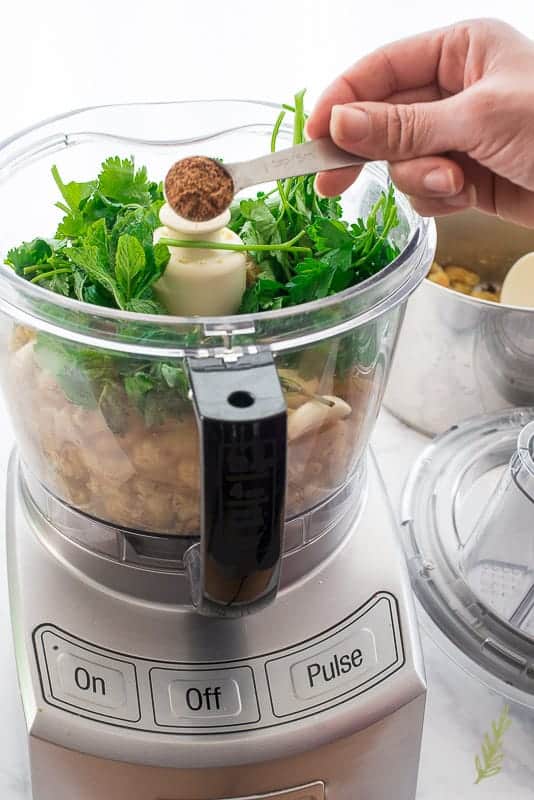
Sadly, but not surprisingly in this world we live; falafel has been the source of some controversy between Arabs and Jews. Palestinian Arabs believe Israeli Jews hijacked the fried balls of yumminess, and obviously the Jews disagree. Strangely enough, though, it was a Coptic Christian who taught me how to make Egyptian falafel. According to Abraham, his people were the first to make falafel in the world. Since they were the best falafel I’d ever had (even until this day), I have no reason to doubt him. Alas, the mystery of who created the falafel goes unsolved.
How do I prep the beans for Egyptian falafel?



In the meantime, you can prep the rest of the ingredients for your falafel mix. Egyptian falafel is much the same as Palestinian, or Israeli, in terms of flavoring.
An IMPORTANT note about Egyptian falafel made with fava beans
Fava beans can cause a flare in those who have G6PD, which is a enzymatic deficiency. It can cause those who suffer from it to develop potentially severe anemia after eating fava beans. If you have been diagnosed with G6PD, you should not consume fava beans, and if you ever experience discomfort after eating them you should probably be tested for this genetic deficiency.
How to flavor Egyptian falafel
Garlic, is the first ingredient I add (after the cooled fava beans) because its the largest item (size-wise) apart from the beans. It needs extra time to break down so I add it first to get it closer to the blade. Add a bit of diced red onion for the same reason- it needs more time to break down.


What do I use to bind falafel?




Transfer your falafel mixture to a bowl and cover with plastic wrap. Refrigerate the mixture for a half, to one hour. This gives the falafel mix time to cool down and for the water to hydrate the mixture. This will help with that crumbling.
This is a great time to clean up any of the prep from mixing the dough, as well as get a pan of corn, or vegetable, oil on to heat for frying.
How do I form the Egyptian falafel?

Scoop and flatten all the mix you can fit onto a plate or platter. Also, make sure you have a separate tray that’s been lined with paper towels to drain the cooked falafel when they come out of the oil.
How do I fry falafel?


Troubleshooting falafel mishaps:
Some adjustments:
- if your falafel disintegrates (falls apart) during frying, you need to add more flour. Start with a tablespoon at a time and retest.
- if your falafel is greasy or soggy (oozes grease when you squeeze it), your oil is too cold, or your pan is too crowded. Fry less falafel at a time, or heat the oil a bit more. Try to maintain the aforementioned frying temps at all times by not crowding the frying pan.
- if your falafel is cooking too fast (two minutes or less), your oil is too hot. Reduce the temperature and fry again.
How should I serve my Egyptian falafel?

Pin this recipe to satisfy any of your future falafel cravings.

Egyptian Style Falafel Made with Fava Beans: Vegetarian and Vegan
at Sense & EdibilityIngredients
- 1 lb 4oz 20oz dried fava beans (about 3 1/2 cups) (not canned) I like Bob's Red Mill
- 7 cups cold water
- 4 cloves of garlic peeled
- 1/4 cup red onion diced
- 1/4 cup Italian parsley roughly chopped
- 1/3 cup cilantro roughly chopped
- 3 tbsp fresh mint roughly chopped
- 2 tsp Middle Eastern Spice Blend or 1 tsp ground cumin and 1 tsp ground coriander
- 1 tsp baking powder
- heavy pinch of kosher salt
- 1/4 cup all-purpose flour plus more as needed
- 3 tbsp of water plus more as needed
- corn or vegetable oil for frying
To serve:
- Thinned tahini sauce
Instructions
- Sort through and rinse the fava beans. Place them into a large stock pot and cover with the water. Bring this to a boil over medium-high heat. Reduce the heat so the water is at a gentle simmer and cook for 30 minutes. Drain and cool the beans completely.
- Once the beans are completely cool, place them in the bowl of a food processor fitted with a blade attachment. Add the garlic, red onion, cilantro, parsley, mint, and Middle Eastern Spice Blend (MESB) to the bowl, and pulse until the mix resembles a coarse sand in texture. Stop mixing and scrape down the bowl using a rubber spatula.
- Add the baking powder, salt and flour. Use the first measurement of flour, only adding more if the mixture is too wet.
- Add the water to the mixture and pulse, once again. Your mixture should be a paste which resembles a thick, chunky peanut butter. If you ball it up and it holds together without crumbling, it's good to go. If you ball it up and it immediately falls apart, it's too dry and needs a little more water. Add a tablespoon of water and pulse again. Then, do the ball test. If it's still too dry, add more water and pulse again.
- Transfer your falafel mixture to a bowl and cover with plastic wrap. Refrigerate the mixture for a half hour to one hour.
- In a large stockpot heat the oil to 350°-375°F. Scoop the falafel mix into your hand using a portion scoop, then flatten slightly. Scoop as much of the mix as you can fit onto a plate or platter. Separately, make sure you have a tray that's been lined with paper towels to drain the cooked falafel on when they come out of the oil.
- Fry four to five balls of falafel at a time for four to four-and-a- half minutes, or until they rise to the surface and are a deep brown color. Remove the balls from the oil using a slotted spoon. Drain them on the paper-towel lined dish. Continue frying until all are cooked.
- Once all your falafel has been fried, serve it immediately. You can also store in a storage container and reheat in the oven on a foil-lined sheet pan. Heat for ten minutes at 350°F, or until warmed through. These falafel freeze amazingly well for up to two months once fried. Enjoy them with this Five Minute Tahini Sauce or on their own.
Notes
Tips for success:
- if your falafel disintegrates (falls apart) during frying, you need to add more flour. Start by mixing in a tablespoon at a time and retest.
- if your falafel is greasy or soggy (oozes grease when you squeeze it), your oil is too cold, or your pan is too crowded. Fry less falafel at a time, or heat the oil a bit more. Try to maintain the aforementioned frying temps at all times by not crowding the frying pan.
- if your falafel is cooking too fast (two minutes or less), your oil is too hot. Reduce the temperature and fry again.
**This post contains affiliate links. To find out what that means to you, please read my disclosure page**
Need More Great Recipes? Check These Out:
PUFFED POTATO PANCAKES WITH
SOUR CREAM AND APPLE BUTTER (LATKES)
Hibiscus, Blood Orange & Cardamom Paletas










I recently made a garbanzo falafel recipe, and that recipe could be baked instead of fried. Do you think it would work to bake these instead of frying?
I’m not entirely sure, but I think so. I recommend baking one or two to test it out. Let me know how it goes and I’ll include those instructions in the post and give you credit!
This is the first time I have made these. I eventually got the temp and the consistency correct. I used my Ninja blender cause that’s what I had. So it was definitely not peanut butter consistency. I am proud that I tried something different!
I’m glad you tried something different too! Different blenders work different ways, but so glad you were able to use something.
Should the skins be removed from the favas before making this recipe, or are they OK in it?
You can leave the skins on, John. I will admit the texture of the pureed fava beans is better when you remove them, but when you consider the amount of extra work peeling them requires, it’s not worth it in my opinion. Hope you like it!
I’m planning on making these with fresh fava beans from the garden–they’re a little past their prime for fresh eating and getting a bit mealy but not yet dry, so I’m thinking that blanched they should have a similar consistency to cooked dried favas. What volume does 20 oz dried favas become once cooked?
Post cooking, they’ll weigh approximately 30 ounces. Although, I don’t know how well the falafel will hold up with fresh (even past their prime) beans. Dried beans are usually preferred for making falafel, so you may have to adjust the amount of flour in the recipe a bit. Good luck!
Your Christian Coptic friend is Egyptian aka Arab. There is no question Palestinian Falafel are Palestinian. It’s called cultural appropriation. Just like the palestinian land was illegal occupied and as time, Israel is also stealing Palestinian culture. There was no such thing as Isreali falafel because it is one of Arabic food throughout the Arab world that is of Palestinian and Egyptian origin just one is cooked with Fava (Egyptian T’maya) and one without (Palestinian).
Did you enjoy the falafel recipe? I understand the tension that exists within the Middle East. I’m not attempting to diminish it with my recipes. There will be countless Israelis who will disagree with you and they’re entitled to their opinion just like you are. My only goal is to provide tasty recipes. Not incite more anger and animosity.